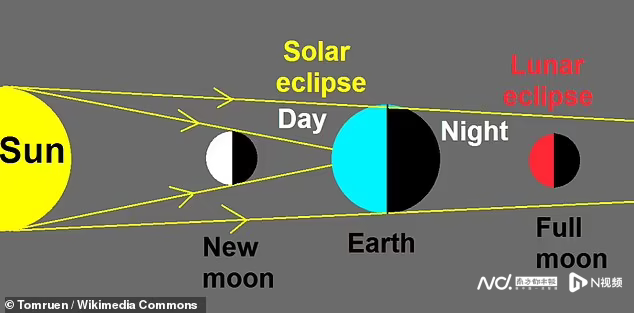NASA said that at 16:28 EST on April 30, the second new moon in April will coincide with a partial solar eclipse, the first eclipse of 2022, which is visible in Antarctica and parts of South America. At the same time, Venus and Jupiter look very close, as if they were staged as a "celestial kiss."
NASA reportedly said that the second new moon in April, known as the "black moon", will occur at 16:28 Eastern Time on April 30 (4:28 Beijing time on May 1). At the same time, people in Antarctica and parts of South America can see partial solar eclipses.
In the evening, the two brightest planets in the night sky, Venus and Jupiter, looked very close, as if they were staging a "celestial kiss."

Schematic diagram of the occurrence of solar and lunar eclipses. When a solar eclipse occurs, the Moon moves between the Sun and the Earth, casting shadows on the Earth, completely or partially blocking the Sun's rays in some areas.
It is reported that when a solar eclipse occurs, the moon moves between the sun and the earth, casting a shadow on the earth, completely or partially blocking the sun's rays in some areas.
During a partial solar eclipse, the apparent motion of the Moon and the Sun do not exactly coincide, so the Moon does not completely cover the Sun.
NASA said that on the evening of April 30, when the sun sets from the west, the sun will appear partially partially eclipsed in the clear skies of Chile, Argentina, much of Uruguay, western Paraguay, southwestern Bolivia, southeastern Peru and a small part of southwestern Brazil.
Eclipses will also be seen in parts of Antarctica's northwest coastline, the Atlantic Ocean off the southeast coast of South America, including the Malvinas Islands (Falkland Islands), and much of the South Pacific and Southern Oceans.
In April, the four planets saturn, Mars, Venus and Jupiter have gradually become more and more consistent in the pre-dawn sky, forming a "four-star continuous pearl" celestial phenomenon.
In April, the four planets saturn, Mars, Venus and Jupiter have gradually become more and more consistent in the pre-dawn sky, forming a "four-star continuous pearl" celestial phenomenon.
The public doesn't need a telescope to see these planets, and viewing works best in clear skies without clouds.
The last time Saturn, Jupiter, Mars and Venus lined up like this was in 2020, and before that in 2016 and 2005.
Text/Nandu reporter Chen Lin